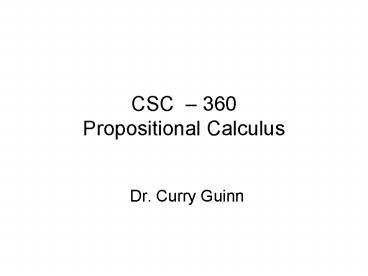CSC 360 Propositional Calculus PowerPoint PPT Presentation
1 / 25
Title: CSC 360 Propositional Calculus
1
CSC 360 Propositional Calculus
- Dr. Curry Guinn
2
Todays Class
- Propositional Calculus
- Well-formed formula
- Rules of inference
- Meaning
- Truth Preservations
- First-Order Logic (First Order Predicate
Calculus)
3
Well-formed formula
- P, Q, R are atoms.
- Atoms are always well-formed
- You can add a to any atom to make a new atom
- x where x is wff
- ltx ? ygt ltx ? ygt ltx ? ygt
- Which are wff on page 182?
4
Rules of Inference
- Allow us to generate new theorems from old
theorems - See sheet
5
Interpretations
- So what do they mean?
- An interpretation in Propositional Calculus is an
assignment of True or False to each atom.
6
Truth Tables
- ltltP ? Qgt ? ltQ ? Pgtgt
- ltltP ? Qgt ? ltP ? Qgtgt
7
All the given rules of inference
- are truth-preserving.
- These rules guarantee the derived statement will
be true if the prior theorems are true - REGARDLESS of the meaning
8
Entailment and Inference
- KB ?. ? is entailed by the sentences in the
knowledge base - For any model where KB is true, ? must also be
true for that model. - KB -i ?. ? can be derived from the knowledge
base given inference procedure i.
9
Inference Procedures
- An inference procedure i is sound (or
truth-preserving) if any sentence generated from
a knowledge base is entailed by the knowledge
base - If KB -i ?, then KB ?.
- An inference procedure i is complete if, for any
sentence that is entailed by KB, then there
exists a proof of KB using i. - If KB ?, then KB -i ?
10
Semantics
- The meaning of a sentence is what it states about
the world. - An interpretation is an assignment of meaning to
a sentence. - Compositional semantics The meaning of a
sentence is a function of the meaning of its
parts. - A sentence is true if the state of affairs it
represents is actually the case. Depends on its
interpretation and the state of the world.
11
Inference
- A sentence is valid if it is true under all
possible interpretations in all possible worlds
(analytic sentences, tautologies). - A sentence is satisfiable if there exists an
interpretation in some world such that the
sentence is true. - A sentence is unsatisfiable if for every possible
world there is no interpretation such that the
sentence is true.
12
Logics
13
Propositional Logic
- Syntax
- Constants True and False. Sentences by
themselves. - Propositional Symbols P, Q, R, .... Sentences
by themselves. - Parenthesis around any sentence is a sentence.
- A sentence can formed by combining sentences
using the logical connectives ????????????and???
- A literal is an atomic sentence (P, Q, R, ...) or
its negation.
14
Propositional Logic
- Semantics.
- An interpretation of a propositional symbol can
be any arbitrary fact. - Meaning of a complex sentence derived from its
parts. - Truth Table.
15
Propositional Logic
- Validity and inference.
- Use a truth table to test for validity.
- ((P ? H) ? ?H) ? P
- Model Any world in which a sentence is true
under a particular interpretation. - A sentence ? is entailed by a knowledge base KB
if the models of KB are all models of ?.
(Whenever KB is true, so is a).
16
Propositional Logic
- Rules of inference.
- Modus Ponens.
- And-Elimination.
- And-Introduction.
- Or-Introduction.
- Double Negation.
- Unit Resolution.
- Resolution.
- P -gt Q p V q. (Material Implication (Impl.)).
- (p AND Q) p V q. De Morgans Laws (De M.).
- (p V Q) p AND q.
17
Propositional Logic
- Complexity
- Determining whether a set of sentences is
satisfiable is NP-complete.
18
Propositional Logic
- Use a truth table to determine whether the
sentence is a tautology, self-contradictory or
contingent - (p -gt (p -gt q)) -gt q.
- p -gt ((p -gt q) -gt q).
- p -gt (p -gt (q AND q)).
- Prove using rules of inference
- A -gt B, (A AND B) -gt C Therefore A -gt C.
19
First-Order Logic
- Also called first-order predicate calculus
- There are objects with properties and relations
between objects. - Syntax Constants, Predicate Symbols, Functions.
Terms are either constants or functions.
20
Sentences
- Atomic Predicate symbol followed by a list of
terms in parenthesis. - Complex Sentences conjoined by logical
predicates. - Quantifiers Allow specifying properties of
collection of objects. - Quantify over objects.
21
Universal Qualifier (?)
- For all ...
- ??x Cat(x)???Mammal(x)???For all objects, if an
object is a cat, then the object is a mammal. - ??x Cat(x)???Mammal(x)??? All objects are cats
and all objects are mammals.
22
Existential Quantifier (?)
- There exists ...
- ? x Sister(x,Spot) ?? Cat(x). There exists an
object such that the object is a sister of Spot
and the object is a cat.
23
Using First-Order Logic
- Domain a subset of the world
- The kinship domain
- ?m,c Mother(c)m ? Female(m) ? parent(m,c).
- ?p,c Parent(p,c) ? Child(c,p).
- ?g,c Grandparent(g,c) ? ?p (Parent(g,p) ?
Parent(p,c)). - ?x,y Sibling(x,y) ? ?(xy) ? ?p (Parent(p,x) ?
Parent(p,y)).
24
Axioms, definitions, theorems
- An axiom is a basic fact about a domain.
- We try to derive theorems from the axioms.
- An independent axiom cannot be derived from other
axioms. - We would like to produce a minimal set of axioms
that are independent. - Why might you use redundancy?
- An axiom of the form ?x,y P(x,y) ?... is often
called a definition of P.
25
For Next Class, Tuesday
- Homework due next Tuesday
- Read about the Diagonalization Argument in
Chapter XIII of GEB - Quiz

